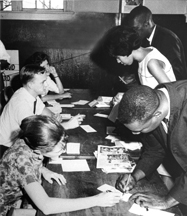| |

Home
|
|
| |
1963-2013: Desegregation—Integration |
|
|
|
|
| |
Thoughts and Reflections about
the Desegregation of
University of South Carolina
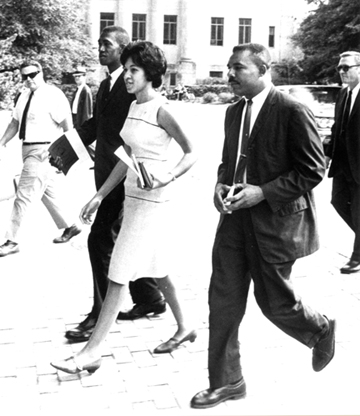
Robert Anderson, Henrie Dobbins Monteith, and James Solomon
walking to Hamilton College for the USC press conference.
|
|
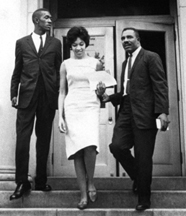
The nature of race relations in Columbia and SC in 1963
|
|
|
|
|
| |
|
|
|
|
|
|
|
|
|
When the University of Alabama desegregated in June 1963, USC became the last racially segregated flagship state university in the south. One year earlier the University of Mississippi campus had erupted into riots with the enrollment of James Meredith. Mississippi Governor Ross Barnett encouraged “all friends” of the state to come to campus to help resist the desegregation order, and many South Carolinians felt that then-Governor Fritz Hollings should lead a motorcade to Oxford, Mississippi as a show of support for Governor Barnett and Ole Miss. Thousands rioted resulting in two deaths and hundreds jailed.
Fearful of such violence in South Carolina, governors and university presidents promised a peaceful desegregation with the often repeated phrase “with dignity.” Governor Hollings in his farewell address as governor to the General Assembly stated, on January 9, 1963, that the desegregation of the state’s universities was impending and “should be done with dignity. It must be done with law and order.” Incoming Governor Donald Russell, former president of USC who had previously praised Governor Barnett for his “courage and resolution,” staged as part of his 1963 inaugural festivities an outdoor barbecue at the governor’s mansion “for all people of South Carolina” suggesting the importance of racial desegregation for the state. The emblematic phrase “with dignity” became for some Carolinians code suggesting that South Carolina had indeed “run out of courts” and must accept the inevitable federally-ordered desegregation; for others, dignity reflected the thoughtful efforts of community leaders as they embraced cultural change without violence and bloodshed. |
|
|
|
|
|
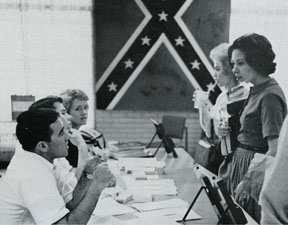
USC Student Council elections during the 1963-1964 academic year.
|
|
|
|
|
|
Other attempts to desegregate the University of South Carolina “Blacks made numerous efforts from 1937 to 1960 to gain admission into USC. In 1937, Charles Bruce Bailey, grandson of Parris Simkins, who graduated from USC Law School in 1876, sought and was denied admission to the law school. In June 1946, John H. Wrighten III, a senior at South Carolina State College, applied to the law school and was denied because of his race. . . .
In 1958, eleven black students from Allen University, who included Thelma McClain, Mary Hatton, James Jones, Cornell F. Mitchell and Loretta Jenkins, attempt to enroll at USC. They were denied admission. In 1960, Lloyd and Raymond Weston, two South Carolina State College students, applied for admission and were denied.” From Civil Rights in South Carolina: From Peaceful Protests to Groundbreaking Rulings by James L. Felder, 2012, pp. 114-115. |
|
|
|
|

Student orientation group stopping at the Maxcy Monument on the Horseshoe.
|
|
|
|
|
Reaction to the impending desegregation
The issue of racial desegregation “remained at the center of public dialogue on the Carolina campus and in the state in early 1963, as evidenced by a controversy that erupted when the Gamecock published Henrie Monteith’s photograph and a story about her court case on its front page. Readers assailed the newspaper for giving coverage to what they called ‘a negro publicity seeker and agitator.’ . . . In May 1963 a group of about 200 Carolina students protested integration on the campus. They burned a cross in front of the president’s home and marched to the state house chanting ‘Two, four, six, eight, we don’t want to integrate!’”
From A History of the University of South Carolina 1940-2000
by Henry H. Lesesne, 2001, pp. 143-144.
|
|
|
|
|
|
|
|
|
|
|
|
|
|
|
|
|
|
|
|
|
|
|
|
|
|
|
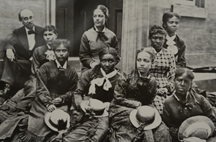

![]()




